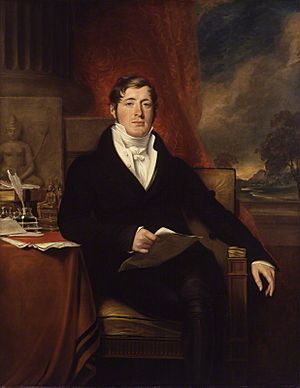George Francis Joseph facts for kids
George Francis Joseph (born in 1764, died in 1846) was a talented English artist who painted many portraits. He was known for capturing people's likenesses in his paintings.
About George Francis Joseph's Life
George Francis Joseph was born on November 25, 1764. When he was about 20 years old, in 1784, he started studying art at the famous Royal Academy in London. This was a big step for any young artist!
In 1813, his hard work paid off. He was chosen to become an Associate of the Academy. This means he was recognized as an important artist by his peers. He worked in London until 1836. After that, he moved to Cambridge, where he passed away in 1846. He was buried in St. Michael's churchyard. Even in his final year, he continued to show his paintings at the Royal Academy.
His Famous Artworks

In 1792, George Francis Joseph won a special award: the Royal Academy gold medal. He earned it for a painting called Scene from Coriolanus. He had first shown his art at the Academy in 1788. After that, he regularly displayed his paintings there and at another important art place called the British Institution.
In 1797, he painted a well-known portrait of Mrs. Siddons as the Tragic Muse. The British Institution also gave him awards, called premiums, for his paintings. He received one in 1811 for Return of Priam with the dead body of Hector. The next year, in 1812, he won another for his Procession to Calvary.
While Joseph sometimes painted imaginative scenes or designed pictures for books, he is most famous for his portraits. He created many portraits, both large oil paintings and smaller miniature ones. Some of these portraits were later turned into engravings. His paintings of important people like Spencer Perceval (from 1812) and Sir Stamford Raffles (from 1817) are now kept in the National Portrait Gallery, London.

